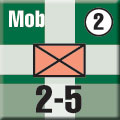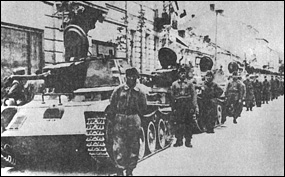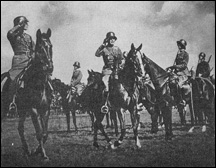| Defiant Russia:
The
Hungarian Fast Corps, 1941
By Mike Bennighof, Ph.D.
February 2022
"We have thrown away our honor.
We have joined the side of gangsters."
Pál Teleki, Hungarian
Prime Minister
Suicide note, April 1941
 Unlike Finland and Romania, Hungary was not
part of the official planning for Operation
Barbarossa, the treacherous Axis attack on
the Soviet Union. Two months earlier, German
planners had counted on full Hungarian participation
in the attack on Yugoslavia, a plan thrown
into disarray at the last moment by the suicide
of Prime Minister Pál Teleki upon learning
of his nation’s planned betrayal of
its “Treaty of Eternal Friendship”
with Belgrade. Unlike Finland and Romania, Hungary was not
part of the official planning for Operation
Barbarossa, the treacherous Axis attack on
the Soviet Union. Two months earlier, German
planners had counted on full Hungarian participation
in the attack on Yugoslavia, a plan thrown
into disarray at the last moment by the suicide
of Prime Minister Pál Teleki upon learning
of his nation’s planned betrayal of
its “Treaty of Eternal Friendship”
with Belgrade.
Hungary did eventually send a small corps
into the Soviet Union, and this unit is present
in our Defiant
Russia game.
 Hungary received German requests to reinforce
her border defenses in early June 1941, but
not until a week before the 22 June attack
did the Germans let the Hungarians in on their
reasons. When the attack began, Adolf Hitler
demanded that Hungary declare war on the Soviet
Union; Hungarian Regent Nicholas Horthy refused
to even sever diplomatic relations, citing
the clauses in the Axis treaty that spelled
out the defensive nature of the alliance. Hungary received German requests to reinforce
her border defenses in early June 1941, but
not until a week before the 22 June attack
did the Germans let the Hungarians in on their
reasons. When the attack began, Adolf Hitler
demanded that Hungary declare war on the Soviet
Union; Hungarian Regent Nicholas Horthy refused
to even sever diplomatic relations, citing
the clauses in the Axis treaty that spelled
out the defensive nature of the alliance.

Toldi 1 tanks of the Hungarian Mobile
Corps, 1941.
|
On the next day the chief of the Hungarian
General Staff, Gen. Henrik Werth, urged the
Cabinet to declare war. As a compromise, the
government finally recalled its ambassador
from Moscow. And there things might have remained,
but on the 26th unidentified aircraft bombed
two Hungarian cities and strafed a train.
Just where these aircraft came from, or who
piloted them, remains unclear almost 65 years
later. But the Hungarian public blamed the
Soviets, and on the 27th Hungary declared
war on the Soviet Union.
The grandly-named “Carpathian Army
Group” was ordered to commence a general
offensive through the Carpathian Mountains
and into the Soviet-occupied zone of southern
Poland. But operations were hampered by the
fact that, despite a long military tradition,
the Royal Hungarian Army (Kiralyi Honvédség)
was simply not very good. Mobilization came
slowly, training was deficient, and the troops
poorly armed.
Thus the “army group” began its
offensive with just two brigades: 1st Mountain
and 8th Border Guard. Within a few days they
were joined by the “Mobile Corps”
of one cavalry and two motorized brigades.
Over the next four days, while German panzer
spearheads raced forward over huge stretches
of ground, the Hungarians advanced only 10
kilometers.
On 9 July the Carpathian Army Group was broken
up, with the mountain and border guard brigades
re-assigned to wipe out Soviet units still
resisting in the rear areas and the Mobile
Corps of three brigades assigned to the German
17th Army. All three brigades contained a
mixture of motorized, horsed and bicycle battalions;
a mixture that was thought to allow mobility
in any sort of terrain but in practice limited
the unit to the pace of its slowest component
(usually the cyclists).

A Hungarian “Nimrod” anti-aircraft
tank. Yes, that’s its real name.
|
Throughout July the corps saw much more action,
and at the end of the month recorded a signal
success, participating in the encirclement
at Uman. The Hungarians fought well over the
next few weeks, and were assigned an important
mission, capture of the Black Sea port of
Nikolayev (most likely to help balance the
Romanian responsibility for taking Odessa).
A four-day battle resulted in the city’s
fall, though most of the defenders escaped
to fight another day and the shipyard workers
had plenty of time to destroy the warships
on the slipways there. Though much was made
of the capture, the Hungarians had been placed
under a German corps command and did not plan
the operation.
The fall of Nikolayev led to a confrontation
within the Hungarian leadership over their
future role in the war. Werth and some of
his generals pressed for full commitment,
with more divisions dispatched to the east
to join the German war effort. Prime Minister
László Bárdossy and most
of the civilians believed the war was almost
over, that Hungary had done enough and it
was time tio take advantage of German success
to withdraw her forces. After some wrangling
Horthy came down on the side of the civilians
and fired Werth.
In September the cavalry brigade was returned
to Hungary, as it had lost most of its horses
and was no longer considered combat-capable.
Its motorized and bicycle components remained
at the front to bolster the greatly-reduced
motorized brigades, which had lost up to 80
percent of their vehicles. Horthy agreed to
a German request to send four infantry brigades
for occupation duties; when they took their
posts the motorized, mountain and border guard
units would all return home.
Before this could take place, the Soviets
launched a counter-offensive at Izyum and
the Germans rushed the Hungarian brigades
into the breach. They fought well there, but
a grinding form of trench warfare developed
in freezing temperatures by the end of the
month and the corps commander, Béla
Miklós, flew to Budapest to urge Horthy
to order the troops home. On November 10th
the corps formally departed from the Soviet
Union.

Hungarian hussars in Ukraine, summer
1941.
|
In Defiant Russia, for simplicity’s
sake there are no special rules concerning
the Hungarian corps’ deployment: The
game ends with the December turn anyway. But
Daily Content is all about special rules;
use this or not as you see fit.
Withdrawal
During each Axis Organization Phase starting
with the September turn, the Axis player rolls
one die. On a result of 1, the Hungarian unit
is immediately removed from play, but does
not count toward the casualty total for victory
purposes. Subtract one from the die roll on
each subsequent turn (so that the Hungarians
are removed on a roll of 1 or 2 in October,
1 through 3 in November and 1 through 4 in
December).
You can order Defiant Russia (Playbook Edition) right here.
Please allow an extra four weeks for delivery.
Sign up for our newsletter right here. Your info will never be sold or transferred; we'll just use it to update you on new games and new offers.
Mike Bennighof is president of Avalanche Press and holds a doctorate in history from Emory University. A Fulbright Scholar and NASA Journalist in Space finalist, he has published an unknowable number of books, games and articles on historical subjects.
He lives in Birmingham, Alabama with his wife, three children and his dog, Leopold.
Want to keep Daily Content free of third-party ads? You can send us some love (and cash) through this link right here.
|
